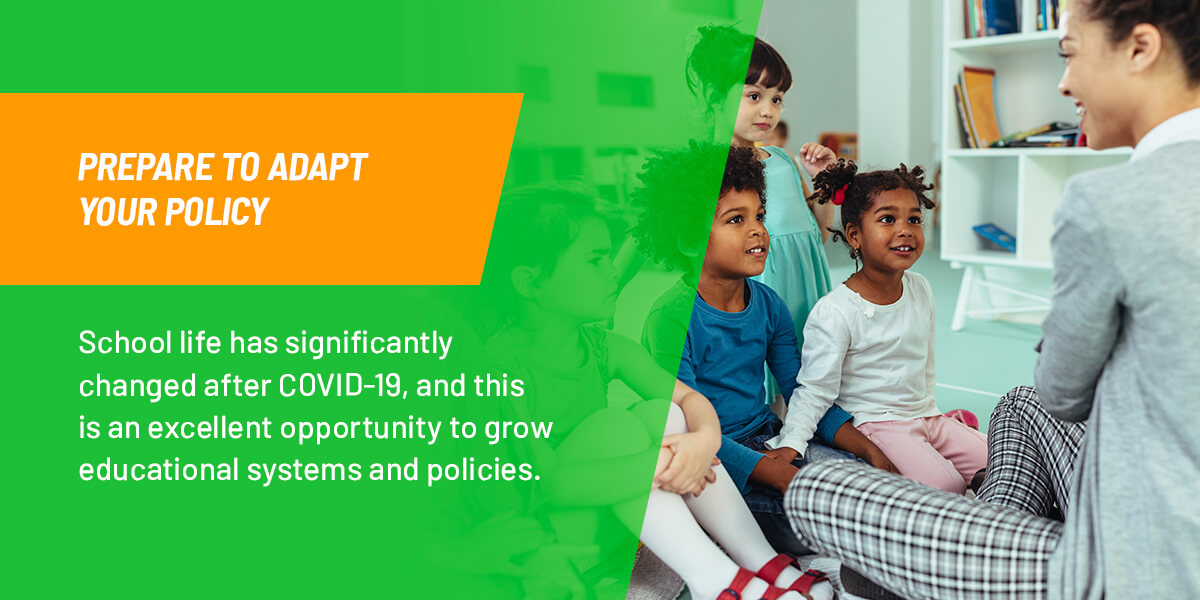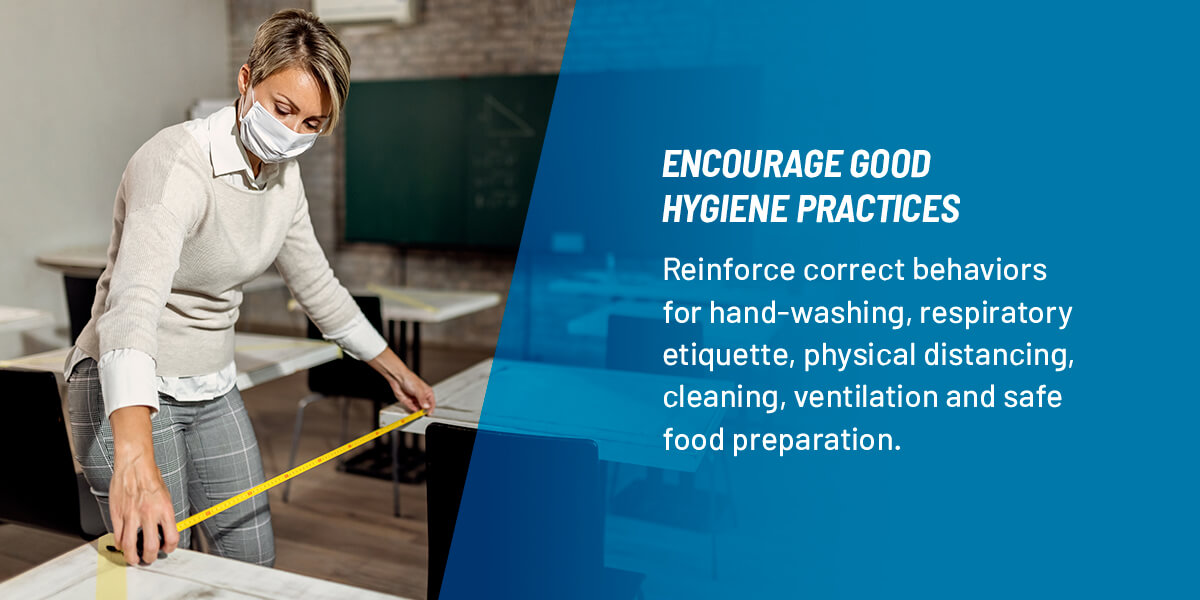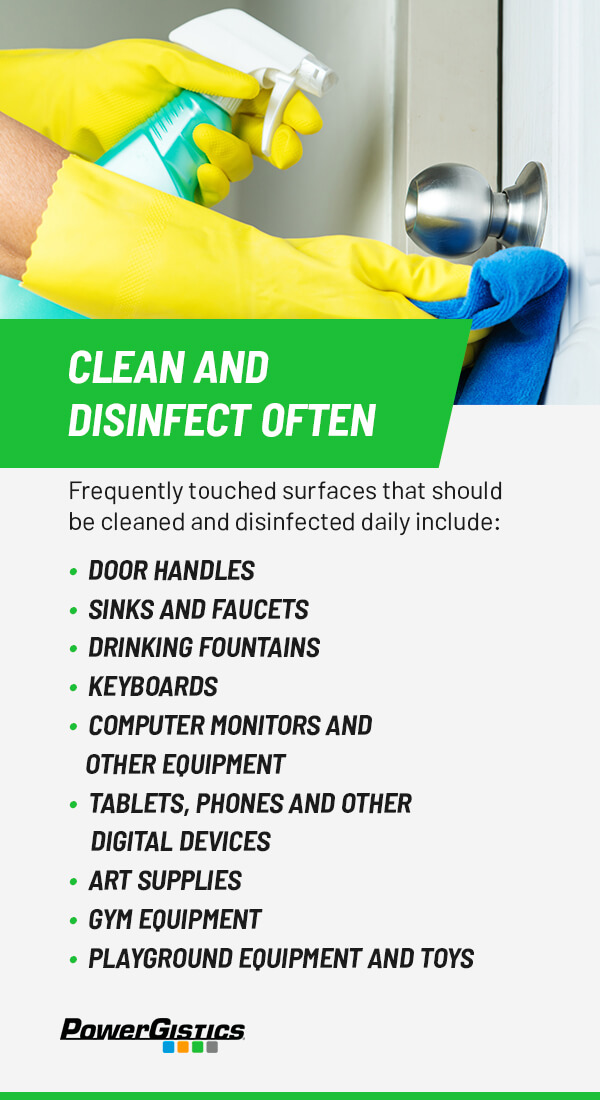10 Ways to Make Your School Safer in a Post COVID-19 World
May 28, 2021
With the COVID-19 vaccine widely accessible across the nation, more people are becoming fully vaccinated. As of May 13, 2021, the Centers for Disease Control and Prevention (CDC) updated their mask and physical distancing recommendations to prepare for full vaccination.
Fully vaccinated people can now enter most settings without masks and may refrain from physical distancing. However, various laws, rules and regulations will continue to enforce these prevention strategies in specific locations. Local business and workplace policies may still require people to wear masks or physically distance until further notice.
So, how will this protocol impact our school systems?
School Protocols for COVID-19 Control
The CDC recommends continued use of COVID-19 prevention strategies for the remainder of the current school year, including universal and correct mask use and physical distancing. School boards may decide to adjust their safety policy and systems in the future, though the CDC has not yet provided guidance for such changes. At the moment, schools can finish the 2020-2021 academic year with consistent use of virus prevention protocols.
Students aged 15 and younger will not be fully vaccinated by the end of the current school year, meaning schools are still at higher risk of virus transmission. Children between the ages of 12 and 15 have just become eligible, while those even younger do not currently qualify for vaccination. To ensure student safety, schools should continue to adopt previous CDC recommendations for:
- Providing access to adequate and timely COVID-19 testing resources.
- Establishing a policy regarding temperature checks and symptom screening of all staff members.
- Offering diagnostic testing referrals to students and staff members exhibiting COVID-19 symptoms at school.
- Developing rapid response plans regarding students and staff members with a fever at school.
- Enforcing self-quarantine of students and staff members who have had known exposure to COVID-19 and were not fully vaccinated.
Moving forward, schools may need protocols for school nurses and nurse aides to measure the temperatures of any students or staff members who become ill at school. The CDC continues to endorse a 14-day quarantine. However, it is ultimately the decision of school boards and local health officials to set guidelines on quarantine based on the probability of spreading infection.
Your school board should keep past CDC recommendations in mind when adjusting their policies for the 2021-2022 academic school year.
How to Make Schools Safer: COVID-19 and Beyond
As we consider our resources and capabilities for the future, schools must do everything they can to ensure the safe return of students and staff members. Schools will need to revise health and behavioral policies, evaluate the physical infrastructure, schedule and staff upcoming classes, plan transportation guidelines and more.
Prioritize school safety for COVID-19 prevention and build safer systems and policies for our continuously evolving world.

1. Prepare to Adapt Your Policy
In response to COVID-19, school boards and government officials needed to develop new learning models for the 2020-2021 academic school year. Most schools are currently using one of the following approaches:
- Remote learning: This model uses technology for class instruction, and students learn from a distance throughout the entire school year.
- In-person schooling: This model uses traditional approaches with enhanced health and safety precautions for preventing infection.
- Hybrid education: This model combines elements of remote learning and in-person schooling.
While our goal should be a return to in-person schooling, we must ensure student safety before making this adjustment. Continue to be flexible in response to new information. School life has significantly changed after COVID-19, and this is an excellent opportunity to grow educational systems and policies.
Prepare for a variety of schooling environments. This way, students and staff members can reduce their anxiety over sudden changes and unknown variables. Empower your school to think critically about life beyond the coronavirus pandemic to determine the best option for students, faculty and student families.
2. Be Confident in Student Safety
Schools should aim to have students physically present in the classroom. This outcome may require you to continue enforcing COVID-19 prevention strategies, even when regulations on mask use and physical distancing have been lifted in other community spaces.
Be consistent with your community’s decisions on various prevention strategies — use them to set minimum requirements for your school and build your policies from there. To make your school safer for in-person schooling, consider any additional control measures that will help with the return of students, teachers and other staff.
Remember, school life will continue to look different from what you were used to before COVID-19. In our excitement to return to normal, we must understand that some change will be necessary to keep students and faculty safe. Continue to communicate with public health authorities, school nurses and other medical experts about ways to return to the classroom confidently.
3. Embrace Technology Tools
Even when most students have returned to in-person learning, some school systems may need to continue offering remote learning opportunities. Many schools adapted their learning situations out of necessity in response to COVID-19. Teachers can now use what they’ve learned from remote instruction to help students both in and out of the classroom.
Technology has played a vital role in the lives of many students and teachers to remain connected. The digital devices and other tools you’ve adopted throughout the journey could have a place at the school. The post-COVID-19 world is evolving, and students can benefit from the continued inclusion of technology in curriculum.
4. Promote Safe Distancing
Physical distancing, or social distancing, helps to maintain a safe level of space between people. When you limit close interactions with others, you significantly reduce the risk of spreading disease and illness. While the CDC has lifted its physical distancing guidelines in all spaces for fully vaccinated people, continued promotion of physical distance can help schools stop more than COVID-19.
Schools oversee hundreds of children every day — opening doors for direct and shared contact between students, teachers and other staff members. When cold and flu season comes, established policies and structural interventions for safe distancing can prevent numerous contamination risks.
You may continue to place desks at least 3 feet apart, with a more considerable distance of 6 feet maintained between teachers and students. Structural barriers, such as clear walls and partitions, can reduce infection risks in classrooms, reception areas and employee workspaces where physical distancing can be challenging to accommodate.
Schools should continue to promote CDC recommendations for 6 feet of physical distancing between people, especially if the school is also revising policies on wearing masks. Avoid making too many adjustments at once to ensure a safe return to the classroom.
Consider School Bus Etiquette
It is challenging to physically distance students while transporting them to and from school. The bus, carpool drop-off or pickup, and building entrance are primary locations for concentrated traffic and large gatherings. Schools that decide to lift physical distancing and mask-wearing policies in the classroom should consider prevention strategies for these areas.
Consistent use of the following CDC recommendations can keep students safe as they arrive and leave school:
- Reduce the number of people on the bus.
- Encourage mask-wearing on the bus and as students enter or leave the building.
- Assign seating on the bus, so the same students sit together each day.
- Maintain 6 feet of distance between the driver and students.
- Clean the bus between use.
- Open bus windows when weather and air quality allow.
- Consider altered start and end times for different grades to minimize entrance traffic.
5. Divide Students Into Cohorts
Many school systems have divided their students into distinct groups or cohorts for the entire school year. This way, there is less interaction between students and staff members in other cohorts. Consider dividing students based on grade or floor and keeping the groups small.
School safety tips to cohort classes for COVID-19 prevention include:
- Consider block schedules with fewer classes in a given day to control hallway movement.
- Eliminate locker usage or assign lockers by cohort in dispersed areas of the building.
- Ensure students are transporting a reasonable number of books and materials daily.
- Provide technology for all students within reason to limit cross-contamination and decrease the number of carried items.
- Rotate teachers into different classrooms instead of students to reduce hallway traffic.
- Utilize outdoor spaces when possible, especially during lunch or activities when increased exhalation occurs.
This method aims to avoid limiting instructional time with shortened schedules or hybrid learning models. Cohorts are a safe way to get all students back to in-person learning.

6. Encourage Good Hygiene Practices
Schools must continue to improve hygiene measures to protect against germs and bacteria. Reinforce correct behaviors for hand-washing, respiratory etiquette, physical distancing, cleaning, ventilation and safe food preparation. Teachers must model proper hand-washing and encourage children to wash hands with soap and water frequently for at least 20 seconds. When a student coughs or sneezes, prioritize hand-washing as an immediate response.
Life after COVID-19 will require heightened health and sanitation protocols to ensure future outbreak prevention. Schools must provide adequate supplies such as soap, safe methods to dry hands, tissues and touchless trash cans. When soap and water are unavailable, supply adults and mature students with hand sanitizer that contains at least 60% alcohol.
7. Develop Routines to Limit Traffic
As we return to in-person learning, daily routines will help make schools safer. Students need more structure in the hallways and space in the classroom to practice safe habits. Simple, low-cost adjustments can limit traffic in heavily congested areas.
Create one-way traffic in school hallways to help students and staff members maintain distance. To prevent over-crowding, develop staggered schedules for different cohorts and consider whether it’s feasible to eliminate the use of lockers. New systems and policies may be required to ensure students are not carrying more than is reasonable.
Students will spend most of their time in the classroom. Help students stick to their routines and provide teachers the tools needed to design safe and effective classrooms. Allow teachers to remove nonessential furniture and use innovative organization. Replace unnecessary furniture and bulky equipment with items like movable whiteboard walls, versatile technology storage towers and slimmer shelving systems. These investments can maximize the classroom layout and clear space for adequate physical distance between desks.
8. Improve Indoor Air Quality
There are several low-cost adjustments schools can make to improve indoor air quality. Aim to increase circulation of outdoor air, increase the efficiency of clean air delivery and eliminate potential contaminants. The following actions can help you achieve a safer school environment:
- Follow proper ventilation strategies in classrooms.
- Inspect heating, ventilation and air conditioning (HVAC) systems for optimal functioning.
- Run HVAC systems continuously at maximum ventilation to improve air exchanges.
- Open windows and doors to improve circulation when weather and outdoor air quality allow.
- Position exhaust fans in restrooms and kitchens to decrease stagnant air and promote circulation.
When weather permits, encourage teachers and students to perform school activities outside. Classes involving singing, band practice, shouting, sports and exercise should generally be conducted outdoors or in well-ventilated spaces.

9. Clean and Disinfect Often
Viruses and germs can survive on particular surfaces for hours or even days. Infections like COVID-19 can quickly spread from a virus contaminated surface to the individual when they touch their eyes, nose or mouth. While frequent hand-washing is vital for infection prevention, cleaning and disinfecting high-touch surfaces can further increase student safety.
Frequently touched surfaces that should be cleaned and disinfected daily include:
- Door handles
- Sinks and faucets
- Drinking fountains
- Keyboards
- Computer monitors and other equipment
- Tablets, phones and other digital devices
- Art supplies
- Gym equipment
- Playground equipment and toys
Regular cleaning with soap and water can significantly reduce the risk of illness. Use disinfectants after cleaning whenever possible, though children should not be present due to the high risk of toxic exposure. Any faculty who will handle disinfectants should be trained on proper procedures and safe usage. Strategic ventilation and the use of personal protective equipment (PPE) can help keep staff members safe from the potential danger of disinfectants and the risk of infection.
10. Eliminate High-Touch Surfaces
In addition to cleaning and disinfecting high-touch surfaces, schools can implement systems and policies that reduce or eliminate cross-contamination. Potential solutions may include:
- Removing the need to touch surfaces that receive frequent use.
- Restricting touch to a limited amount of people.
- Supplying more efficient tools and equipment to the classroom.
Touchless faucets and water fountains decrease the risk of contamination, while separate school supplies contain infection risks to the individual. Provide each student with a personal laptop or tablet to minimize the spread of germs. Innovative technology charging towers can ensure no-touch device management for safe and easy deployment.
Teachers can also restrict who touches the door handle by leaving the door open when students enter the room and closing it themselves at the start of class. Eliminate locker use and section off common spaces to deter students from congregating in tight areas.
Schools should explore these and other options when reducing virus transmission for future academic school years.
Bonus School Safety Tip: Layer Prevention Strategies
When schools layer multiple prevention strategies, they provide students and staff members with the safest learning environment possible. The return to classroom instruction is vital for educational effectiveness, but in-person learning is only possible when schools are safe. Adjust your school systems and policies for the 2021-2022 academic school year with both student safety and educational effectiveness at the forefront of any decision.
Make Your School Safer With Technology Storage Solutions From PowerGistics
For many schools adapting to life after the events of COVID-19, student access to individual devices is vital. Large, bulky charging carts pose many challenges — taking up tons of valuable space and increasing infection risks among students. That’s why PowerGistics offers a safe solution for storing student devices.
The PowerGistics USB Towers efficiently store and charge laptops, Chromebooks, tablets and more. Our space-saving vertical Towers limit traffic with a versatile, split-deployment design. Shop Towers with an antimicrobial coating to slow microorganism growth and protect against germs. Contact PowerGistics and request pricing today.

